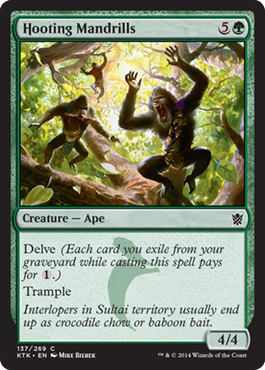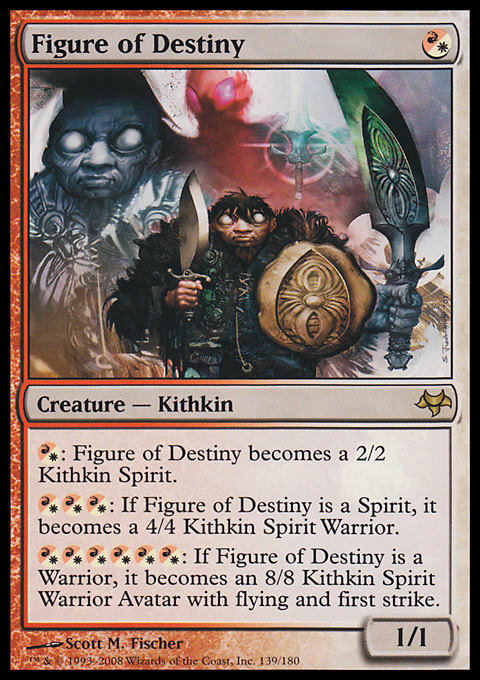In my Khans of Tarkir Cube review, I broke down the cards by mechanic, and in this review, I'll talk about the mechanics as well as other Cube-impacting cards in this powerful set.
Tri-Color Hybrids
Tri-color hybrids are interesting because, like regular hybrids, their ability makes them easier to cast than harder, making them function more like multicolored that can be cast in two pairs than the awkward tri-colors, which require specific triads to use.
The following are the relevant options for Cube:
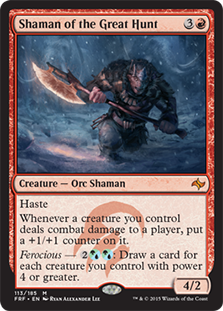 |
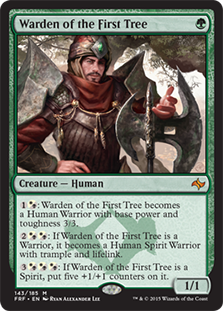 |
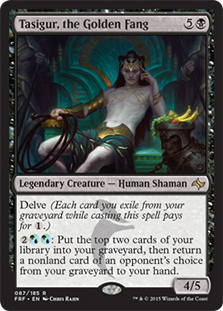 |
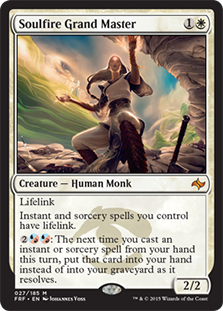 |
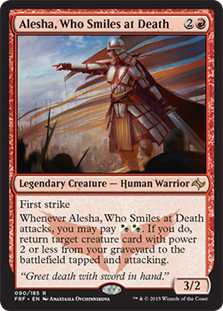 |
 |
Yasova Dragonclaw was the first card spoiled, and its 4/2-trample-for-3 base stats aren't bad as a start. She's a solid add for Gruul aggro decks and not bad for Simic tempo decks, although it's certainly better against decks with single threats to steal and clear out of the way of Yasova's 2 toughness.
Tasigur, the Golden Fang looks to be the best of the tri-color hybrids, as it isn't difficult to gain a good return on mana investment due to its single ![]() in his
in his ![]()
![]() mana cost, as I've seen it typically cast between
mana cost, as I've seen it typically cast between ![]() and
and ![]()
![]() . His delve works incredibly well with his activated ability by getting rid of the graveyard chaff. There's an argument that, since the opponent is able to choose what is brought back with his ability, it's bad. I've found this to be untrue since a lot of the chaff is removed upon casting, and multiple activations can help to put suboptimal cards in the hand, but I've found that it typically acted similarly to drawing a card off the top.
. His delve works incredibly well with his activated ability by getting rid of the graveyard chaff. There's an argument that, since the opponent is able to choose what is brought back with his ability, it's bad. I've found this to be untrue since a lot of the chaff is removed upon casting, and multiple activations can help to put suboptimal cards in the hand, but I've found that it typically acted similarly to drawing a card off the top.
There's another argument that since Hooting Mandrills isn't tearing up Cubes, Tasigur is bad, but this discounts the added flexibility/utility of the Regrowth ability. (After all, no one's playing Shock in their Cubes, but Burst Lightning's flexibility makes it good.)
Warden of the First Tree is a riff on Figure of Destiny—the first mode is about the same, if not slightly worse; the middle ability is definitely worse due to not pumping power or toughness, while still being quite useful; and its ultimate is arguably better. It's weaker than Figure, but that doesn't make it bad, as Figure's a Cube staple. But it's still a solid creature as an early attacker that can grow large in aggro or a Selesnya/Golgari midrange threat that can hold the fort in the early game and grow huge.
Soulfire Grand Master is a card that I've cooled on, as adding lifelink to spells is nice, but not game-breaking, and the 2/2 lifelink body is lackluster. The kicker comes through by providing reach through recursion of spells, with Time Walk being the ultimate dream. That said, it can be hard to Voltron the spell in hand and the mana required to cast it and loop it, but it still works in aggressive decks due to its cheap cost and ability to loop cheap spells. In that same vein, I've found that it's harder to gain value from its activated ability than one may think, as even when combining it with cheap spells, 4 mana is a pretty hefty tax to pay in the long run.
Alesha, who Smiles at Death is interesting in that she works on 2-power creatures, a la Reveillark and Imperial Recruiter, not on 2-mana creatures, although they mostly intersect anyway. It's hard to cheat value out of it aside from Clones (0 power) or cards like Siege-Gang Commander a la Boat Brew, but she works very well, as she has solid base stats as a ![]()
![]() 3/2 with first strike. Attacking 3-drops have historically been in a weak slot for red aggressive decks, aside from Goblin Rabblemaster, and this card helps to recover from removal effects in the later stages of the game.
3/2 with first strike. Attacking 3-drops have historically been in a weak slot for red aggressive decks, aside from Goblin Rabblemaster, and this card helps to recover from removal effects in the later stages of the game.
Second-Tier Tri-Color Hybrids
Shaman of the Great Hunt is a solid attacker as a 4-power haste creature that puts a Curse of Stalked Prey on an opponent and draws cards without much effort aside from the mana (and it has an absurd ceiling), making it a natural fit for aggressive decks. However, it suffers from being weaker than many 4-drops in red aggro decks, which gives it a hard time in smaller Cubes since it may end up losing out when a red aggressive deck has to cut a Koth of the Hammer, Hero of Oxid Ridge, and Flametongue Kavu from its curve-topper slot, making it ride the sideboard more than it should for a card of that power level. It also pales in comparison to Yasova Dragonclaw for Cubes that just want one Temur card, but it's still a solid card.
Brutal Hordechief's Master Warcraft ability allows to take over a game if it does untap, but it suffers from being quite poor if he doesn't have a horde to go alongside with him or if you're behind, making Alesha a better fit for Cubes that just want one Mardu card but a decent second.
 |
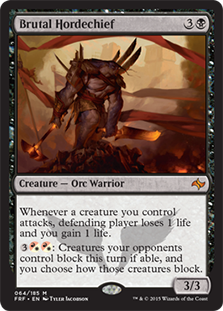 |
 |
Shu Yun, the Silent Tempest is another solid card for Azorius and Izzet tempo decks; I've lately been a fan of Izzet aggro and tempo decks in my Cube, and this fits those strategies well by letting a Lightning Bolt turn into 11 extra damage for ![]()
![]()
![]() if it gives itself double strike, and while its ability requires some mana, it's not necessarily enough to make it cost-prohibitive.
if it gives itself double strike, and while its ability requires some mana, it's not necessarily enough to make it cost-prohibitive.
Others, such as Daghatar the Adamant, and other tri-colors, such as Hungering Yeti, are a bit too low-impact for many Cubes.
I've been running Wild Nacatl in my Cube in with miscellaneous/colorless cards like artifacts and City of Brass, and that's where these will be in my Cube.
Mechanics
Manifest
 Manifest cards are mainly used to generate 2/2s, with a small possibility of upgrading into larger threats. For oversimplification's sake, the percent chance to manifest a creature is 15/40 or 37.5%. Also, some creatures in Cube have enters-the-battlefield triggers, which are a nombo with manifest, but if it's making something better than a vanilla 2/2, that's not necessarily a bad thing, as it's an option to upgrade the 2/2, provided that it's a good use of the mana. (And the feel-bad of it hitting a good noncreature or a creature that would have been better to cast is similar to the feel-bads of being milled: mostly irrelevant.) There's also the surprise/making-combat-awkward factor, but how much mana that's worth is hard to say.
Manifest cards are mainly used to generate 2/2s, with a small possibility of upgrading into larger threats. For oversimplification's sake, the percent chance to manifest a creature is 15/40 or 37.5%. Also, some creatures in Cube have enters-the-battlefield triggers, which are a nombo with manifest, but if it's making something better than a vanilla 2/2, that's not necessarily a bad thing, as it's an option to upgrade the 2/2, provided that it's a good use of the mana. (And the feel-bad of it hitting a good noncreature or a creature that would have been better to cast is similar to the feel-bads of being milled: mostly irrelevant.) There's also the surprise/making-combat-awkward factor, but how much mana that's worth is hard to say.
However, even with those factors in play, due to the low chance of hitting a creature, manifest cards like Cloudform, which are reliant on hitting a creature to get your mana's worth, are weak for Cube.
The exception is Whisperwood Elemental, which provides a ton of power for the cost—assuming that it doesn't die to instant-speed removal, which is a fair assumption—as it spits out 2/2s, which can be upgraded if the manifest hits a creature, with a 4/4 body, which has been a solid package.
Dash
Flexible cards have historically been hard to evaluate, as much of the evaluation focuses on the individual pieces rather than on the whole part—such as focusing on Everflowing Chalice's individual modes being weaker than existing mana rocks while not looking at the overall flexibility.
Dash cards work similarly by acting as part spell and part creature. We've seen some variants of this over the years, with cards with channel (Shinen of Life's Roar) and bloodthirst (Ghor-Clan Rampager).
For aggressive decks, due to noncreature slots being at a premium, those slots need to do a lot of work. Dash creatures help to straddle that line by acting as both depending on the circumstances, like acting as “burst” damage to attack for the win when an opponent taps low or to add to a board position when an opponent has a lot of mass-removal options, like Viashino Sandstalker in Sligh decks.
Look at the following Dash creatures:
 |
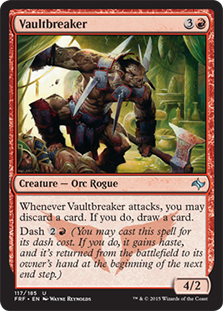 |
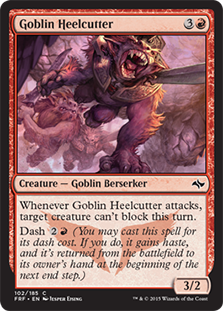 |
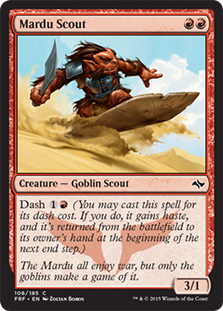 |
 |
Most of these have better dash modes, as they act as spells with damage components, such as how Goblin Heelcutter acts as a mini-Falter with a miniature Viashino Sandstalker on it, and it can be a nice tool for decks that want options against decks with few blockers.
Kolaghan, the Storm's Fury is the best of these as card that works well aggressively as a curve-topper like Falkenrath Aristocrat as a 5-power punch in the air that pumps the rest of the team and typically closes the game out soon after being dashed, but it isn't bad as a non-hasted Thundermaw Hellkite that acts as Orcish Oriflamme as well.
Mardu Strike Leader, on the other hand, is better as an on-curve creature that demands a blocker, but it provides a body even if it is blocked, and it also has the ability to dash itself out for 5 power on board. Mardu Scout would have been a windmill slam in Cubes years ago, but with ![]()
![]() 3-power beaters War-Name Aspirant and Borderland Marauder, it's a harder sell now putting it into competition with cards like Ash Zealot, which it loses out to.
3-power beaters War-Name Aspirant and Borderland Marauder, it's a harder sell now putting it into competition with cards like Ash Zealot, which it loses out to.
Prowess
Aside from the easy inclusion of Monastery Mentor, the mechanic offers little else for Cube in Fate Reforged.
Delve
Aside from Tasigur, there's not much else for delve. Sibsig Muckdraggers, Soulflayer, and Temporal Trespass are too costly for what they do.
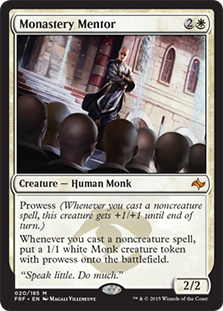 |
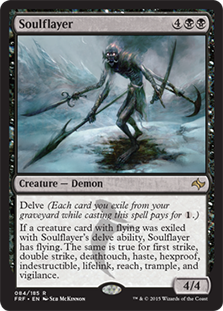 |
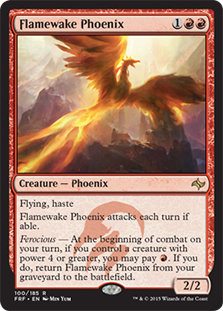 |
Bolster
Bolster is a miss for Cube, but it's because of the cards themselves are overall, not the mechanic itself—much like Abzan's previous keyword, outlast.
Ferocious
As with Khans of Tarkir, the ferocious cards don't have enough of an upside to be worth their effort. Whisperer of the Wilds is counterproductive by providing more mana when you already have big creatures. Flamewake Phoenix has the best chance of making an impact in midrange decks that use it as a one-sided Sulfuric Vortex that can be regrown, as I've found it too difficult to regrow in aggro decks.
Non-Mechanic Cards
 Ugin, the Spirit Dragon comes with a high mana cost, but it's worth it in decks that can consistently ramp into it (most control/ramp decks). As a high-mana-cost card should do, its abilities have worked very well for board control by either wiping the board of (most) threats and then going upstairs with Ghostfires or—if the board's favorable—going upstairs with Ghostfires and threatening an ultimate very quickly. Smaller Cubes may have a harder time including it since it can't be cheated into play outside of Eureka and Channel, but it's very strong otherwise.
Ugin, the Spirit Dragon comes with a high mana cost, but it's worth it in decks that can consistently ramp into it (most control/ramp decks). As a high-mana-cost card should do, its abilities have worked very well for board control by either wiping the board of (most) threats and then going upstairs with Ghostfires or—if the board's favorable—going upstairs with Ghostfires and threatening an ultimate very quickly. Smaller Cubes may have a harder time including it since it can't be cheated into play outside of Eureka and Channel, but it's very strong otherwise.
Frostwalker hits harder than almost anything else in Cube for 2 mana, but I've found that those slots for aggressive slots in blue need to be good enough to run in non-aggressive decks—like cards such as Pestermite or Coralhelm Commander—and Frostwalker isn’t.
Jeskai Barricade is a nice trick as instant-speed trick/blocker as a gating creature with a may trigger. Due to its relatively low impact, it's more of a tool used to support blink/value shenanigans than a staple.
Humble Defector is interesting as an aggressive beater that can be used to cash in for burn when it becomes outclassed, and it can combine with sacrifice shenanigans, but the main deterrent is that it's just too low-impact, and I found that the scenarios of it being cashed in weren’t worth the little board impact as a 2/2. And the dream scenarios of it top-decking reach elements just didn't happen.
Last, Mardu Woe-Reaper is a fantastic aggro beater that should reinforce cards like Elite Vanguard, not replace them.
I hope you enjoyed this overview of what this powerful set brings for Cube!
- @UsmanTheRad on Twitter
- My blog, featuring my Pauper and powered Cube lists
- Cube podcast, The Third Power, that Anthony Avitollo and I host
















